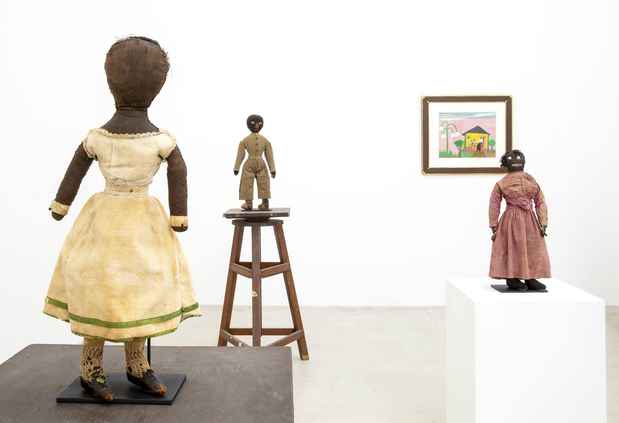“Where The Oven Bakes & The Pot Biles” Exhibition
Shin Gallery (66-68 Orchard St.)

This event has ended.
SHIN GALLERY presents an unprecedented group exhibition of African American formerly enslaved and self-taught artists - David Drake, Joshua Johnson, Bill Traylor, Clementine Hunter, and anonymous potters as well as dollmakers from the 19th-century. The exhibition surveys a historical perspective of African American society during slavery in the antebellum period and following the Civil War. Works span from c.1800s to c.1950s – a critical timeframe commencing from the post-colonial era to the present day.
Curated by Stavroula Coulianidis, the exhibition acknowledges a group of under-recognized artists and skilled craftspeople whose work reveals both spoken and unspoken truths towards racial prejudice. The juxtaposed 19th-century and 20th-century work, demands to enquire history’s impact on the artists’ practices and processes. Viewers are challenged to confront narratives that amass themes of socio-political, spiritual, and racial implications relevant in past and present times.
To be exhibited for the first time in a gallery, rare pieces of stoneware by David Drake (1801-1865), a formerly enslaved potter, stand valiant. Born into slavery in 1801, Drake was trained as a potter in Edgefield, South Carolina. A master ‘turner’ and admired for his unique style, Drake produced hundreds of pots and jars under his owners; the most notable being Mr. Lewis Miles. As utilitarian stoneware was a valuable asset to the economy, large pots and jars were sold to locals or used to store massive lards of meat for slaves working on the plantation.
Perhaps the most compelling aspect of Drake’s work lies in written word. The potter was revered for his ability to read and write. Despite harsh anti-literacy laws, Drake inscribed poems and signatures on the surface of his ceramics. The exhibition examines the hidden inscriptions, craft, and rebellious yet subtle nature of an individual who by-passed the law to write forbidden words on an unforgiving medium.
The face jugs displayed suggest stoneware may have also been valued as a form of artistic expression. Created by anonymous potters, the objects likely served various functions, such as holding water for ritualistic ceremonies or placing on graveyards. Although they remain enigmatic in their purpose, the unique characteristics allude to greater cultural and societal dilemmas. A cabinet card entitled, The Wilde Woman of Aiken (1882) taken by photographer James A. Palmer, depicts a woman seated next to an Edgefield face jug. The racially offensive image captures the demeaning interrelation between face jugs and African Americans prevalent in the 19th century.
Striking works by the acclaimed self-taught artist Bill Traylor (1854-1949), reveal further memories of segregated culture. Born into slavery in 1854 on a cotton plantation in Alabama, Bill Traylor is renowned for his modest and authentic characters seen in daily life. Finding himself homeless during the Great Depression, Traylor began to draw in his late eighties. Whether animals or individuals, the reoccurring subject matter depicts vivid details of the plantation Traylor lived and worked. Placed alongside Traylor’s work are documents and invoices of slaves written in the 1800s. The papers are a testament to the disconcerting acts realized in everyday life.
Addressing segregation implicitly, “Portrait of a Woman” by Joshua Johnson (1763-1832), depicts an aristocratic female posing in a gold dress and bonnet. Recognized as the first professional African American painter in history, Johnson is distinguished for his paintings of children, families, or upper-class individuals. The son of a slave woman and white man, Johnson was purchased in 1764 by Mr. William Wheller. He was later released by his father in 1782 and shortly after began his career as a portraitist for wealthy families in Baltimore, Maryland. Fewer than one hundred paintings are known to exist by Johnson; all of which depict white individuals.
A rare selection of handmade black dolls from the 19th century reinforces the central motif of racial perception. The evocative figures are largely thought to be created by anonymous African American enslaved women for their own children or for the children they looked after. With limited available materials, dollmakers gathered scraps of fabric, cloth, and thread to sew the domestic toys.
Once cuddled and cared for, each of the seven dolls embody an individualistic persona. Expressive features, distorted bodies, and asymmetrical faces are suggestive of a black maker. Whether or not intentional, the dolls respond to a stigma and attitude towards race. The creation of dolls made from home fabric exemplifies an act of resistance and holds a powerful political message regarding segregated societies.
Working and living on Melrose Plantation in Louisiana, female artist Clementine Hunter (1887-1988), revisits her poignant life through painting. Self-taught in her fifties, Hunter depicts scenes of past memories such as picking cotton, washing clothes, and attending plantation funerals or baptisms. Acknowledged as a remarkable visual storyteller, Hunter illuminates the complex racial and religious issues experienced in her lifetime.
Media
Schedule
from March 03, 2021 to April 11, 2021